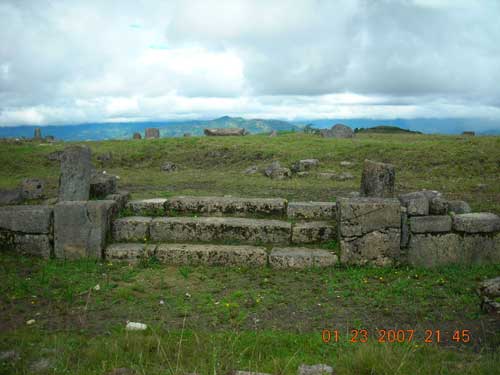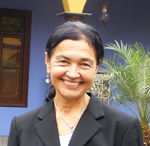|
Pacopampa
Pacopampa ( qu, paqu pampa) is an archaeological site located in the northern highlands of Peru, in the department of Cajamarca. It presents the remains of a monumental ceremonial center, made with cut and polished stone. It belongs to the Formative period, dating from 1200 to 500 BC. The land where the reservoir extends belongs to the National University of San Marcos, which through its ''Rural Andean History Seminar'' cares permanently for the monument. Geographical location It is within the village of Pacopampa at 2140 m in the Querocoto District of the province of Chota, Cajamarca Region. It is among the largest ceremonial centers of the northern highlands of Peru. At its surroundings a dozen of archaeological sites have been identified, which a couple have been studied. These are called Chapel and El Mirador, located one kilometer east. Further, 3 km southeast, is Pandanche another Formative period ceremonial center. Research In the 1930s Rafael Larco Hoyle visited ... [...More Info...] [...Related Items...] OR: [Wikipedia] [Google] [Baidu] |
Rafael Larco Hoyle
Rafael Larco Hoyle (18 May 1901 in Chicama Valley, Peru – 23 October 1966, Lima), raised at Chiclin, his family's estate, was sent to school in Maryland, United States, at the age of twelve. He later entered Cornell University to study agricultural engineering and by 1923 returned to Peru to work on the family's sugar cane plantation. After spending most of his youth abroad, Larco Hoyle arrived to Peru with the eyes of an outsider. With this foreigner's curiosity he explored the country and discovered an ancient cultural patrimony in the north coast. Larco Hoyle recognized the need to house these objects in a safe place. It was at that point, Larco Hoyle dreamt of a museum, one like he had seen in the United States. In 1925, Larco Hoyle's father, Rafael Larco Herrera acquired a collection of vases and other archaeological pieces from Alfredo Hoyle, his brother-in-law. There were approximately 600 ceramic pieces in all. The arrival of these objects ignited a collector's enth ... [...More Info...] [...Related Items...] OR: [Wikipedia] [Google] [Baidu] |
Querocoto District
Querocoto District is one of nineteen districts of the province Chota in Peru. Instituto Nacional de Estadística e Informática The Instituto Nacional de Estadística e Informática (INEI) ("National Institute of Statistics and Informatics") is a semi-autonomous Peruvian government agency which coordinates, compiles, and evaluates statistical information for the country .... Banco de Información Distrital''. Retrieved April 11, 2008. References {{coord, 6, 21, 31, S, 79, 02, 08, W, source:kolossus-eswiki, display=title ... [...More Info...] [...Related Items...] OR: [Wikipedia] [Google] [Baidu] |
Archaeological Sites In Cajamarca Region
Archaeology or archeology is the scientific study of human activity through the recovery and analysis of material culture. The archaeological record consists of Artifact (archaeology), artifacts, architecture, biofact (archaeology), biofacts or ecofacts, archaeological site, sites, and cultural landscapes. Archaeology can be considered both a social science and a branch of the humanities. It is usually considered an independent academic discipline, but may also be classified as part of anthropology (in North America – the four-field approach), history or geography. Archaeologists study human prehistory and history, from the development of the first stone tools at Lomekwi in East Africa 3.3 million years ago up until recent decades. Archaeology is distinct from palaeontology, which is the study of fossil remains. Archaeology is particularly important for learning about prehistoric societies, for which, by definition, there are no written records. Prehistory includes ove ... [...More Info...] [...Related Items...] OR: [Wikipedia] [Google] [Baidu] |
Archaeological Sites In Peru
Archaeological sites in Peru are numerous and diverse, representing different aspects including temples and fortresses of the various cultures of ancient Peru, such as the Moche and Nazca. The sites vary in importance from small local sites to UNESCO World Heritage sites of global importance. Their nature and complexity of the sites vary from small single-featured sites such as pyramids to entire cities, such as Chan Chan and Machu Picchu. Preservation and investigation of these sites are controlled mainly by the Culture Ministry (MINCUL) ( es, Ministerio de Cultura (Perú)). The lack of funding to protect sites and enforce existing laws, results in large scale looting and illegal trading of artifacts. Sites The following is an alphabetical list of archaeological sites in Peru, it lists the main archaeological sites of touristic importance as published by the Ministry of Foreign Commerce and Tourism. Archaeology of PeruArchaeological sites Retrieved March 3, 2009. See also * Cu ... [...More Info...] [...Related Items...] OR: [Wikipedia] [Google] [Baidu] |
Cinnabar
Cinnabar (), or cinnabarite (), from the grc, κιννάβαρι (), is the bright scarlet to brick-red form of Mercury sulfide, mercury(II) sulfide (HgS). It is the most common source ore for refining mercury (element), elemental mercury and is the historic source for the brilliant red or scarlet pigment termed vermilion and associated red mercury pigments. Cinnabar generally occurs as a vein-filling mineral associated with recent volcanic activity and alkaline hot springs. The mineral resembles quartz in symmetry and in its exhibiting birefringence. Cinnabar has a mean refractive index near 3.2, a mohs scale of mineral hardness, hardness between 2.0 and 2.5, and a specific gravity of approximately 8.1. The color and properties derive from a structure that is a hexagonal crystalline bravais lattice, lattice belonging to the trigonal crystal system, crystals that sometimes exhibit Crystal twinning, twinning. Cinnabar has been used for its color since antiquity in the Near East ... [...More Info...] [...Related Items...] OR: [Wikipedia] [Google] [Baidu] |
Ruth Shady
Ruth Martha Shady Solís (born December 29, 1946, Callao, Perú) is a Peruvian anthropologist and archaeologist. She is the founder and director of the archaeological project at Caral. Career Throughout her career, she has directed many different projects of archeological investigation on the coast, the highlands and the rain forests of Peru, placing emphasis on the study of the development of the complex socio-political organizations. She was director of the Museo Nacional de Arqueología y Antropología del Perú ( National Museum of Archaeology and Anthropology of Peru), and director of the Museum of Archeology and Anthropology of National University of San Marcos. She has worked at the Caral site from 1994 onwards and is credited with the discovery of Norte Chico, the first known civilization of the Americas, and one of the oldest in the world. Shady has named the civilization after Caral, while the term Norte Chico has been adopted in English. In 2001, Shady and others ... [...More Info...] [...Related Items...] OR: [Wikipedia] [Google] [Baidu] |
Chavin Culture
Chavin may refer to: Places * Chavín de Huantar, an archaeological site in Peru built by the Chavín culture * Chavín District, Chincha, Peru * Chavín de Huantar District, Huari, Peru * Chavín de Pariarca District, Huamalies, Peru * Chavin, Indre, a commune of the Indre ''département'' in France * Chavin, Iran, a village in Kurdistan Province, Iran * The Chavín parish belonging to the municipality of Viveiro, Spain Other uses * Chinga Chavin, U.S. musician * Chavín culture, an early culture of the Andean region, pre-dating the Moche culture in Peru * Operation Chavín de Huántar Operation Chavín de Huántar was a military operation in which a team of 142 commandos of the Peruvian Armed Forces ended the 1997 Japanese embassy hostage crisis by raiding the Japanese ambassador's residence and freeing the hostages held ther ..., a Peruvian military operation that ended the 1997 Japanese embassy hostage crisis * Rhinella chavin (''R. chavin''), a species of toad See al ... [...More Info...] [...Related Items...] OR: [Wikipedia] [Google] [Baidu] |
Larco Museum
The Larco Museum (officially known as Rafael Larco Herrera Archaeological Museum, in es, Museo Arqueológico Rafael Larco Herrera, links=no) is a privately owned museum of pre-Columbian art, located in the Pueblo Libre District of Lima, Peru. The museum is housed in an 18th-century vice-royal building. It showcases chronological galleries that provide a thorough overview of 5,000 years of Peruvian pre-Columbian history. It is well known for its gallery of pre-Columbian erotic pottery. History In 1925, Rafael Larco Herrera acquired a collection of vases and other archaeological pieces from his brother-in-law, Alfredo Hoyle. There were approximately 600 ceramic pieces in all. The arrival of these objects ignited a collector's enthusiasm in his son, Rafael Larco Hoyle. Soon after, Larco Herrera left his son in charge of the collection and those pieces completed the first collection of what would become the Rafael Larco Herrera Museum. During that same year, Larco Hoyle received so ... [...More Info...] [...Related Items...] OR: [Wikipedia] [Google] [Baidu] |
Chota Province
Chota Province is a province of the Cajamarca Region in Peru , image_flag = Flag of Peru.svg , image_coat = Escudo nacional del Perú.svg , other_symbol = Great Seal of the State , other_symbol_type = Seal (emblem), National seal , national_motto = "Fi .... The capital of the province is the city of Chota. Political division The province measures and is divided into nineteen districts: See also * Kuntur Qaqa References * Instituto Nacional de Estadística e Informática. Banco de Información Digital'. Retrieved December 24, 2007. Provinces of the Cajamarca Region {{Cajamarca-geo-stub ... [...More Info...] [...Related Items...] OR: [Wikipedia] [Google] [Baidu] |
University Of San Marcos
The National University of San Marcos ( es, Universidad Nacional Mayor de San Marcos, link=no, UNMSM) is a public research university located in Lima, the capital of Peru. It is considered the most important, recognized and representative educational institution at the national level. At the continental level, it is the first officially established (Privilege (legal ethics), privilege by Charles V, Holy Roman Emperor) and the List of oldest universities in continuous operation#Latin America and the Caribbean, oldest continuously operating university in the Americas, which is why it appears in official documents and publications as "''University of Peru, Dean University of the Americas''". It had its beginnings in the general studies that were offered in the cloisters of the convent of the Rosario of the order of Santo Domingo —current Basilica and Convent of Santo Domingo, Lima, Basilica and Convent of Santo Domingo— around 1548. Its official foundation was conceived by Fray ... [...More Info...] [...Related Items...] OR: [Wikipedia] [Google] [Baidu] |


.jpg)


